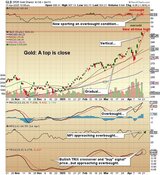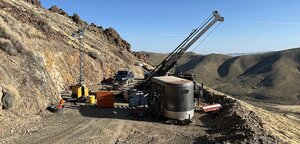Chris Berry: Because the industrial metals are my primary focus, I pay close attention to metrics geared toward industrial activity. This includes Purchasing Manager Indices (PMI), industrial production data and capacity utilization data. I also look at the velocity of money as a signal of inflation. These data points are forward-looking indicators and are a reasonable gauge of the expansion or the contraction in an economy's industrial base. Additionally, the PMI data in particular gives a more granular look at economic activity including new orders, inventory, prices and output. This granularity is helpful in accurately gauging the expansion or contraction of an economy's industrial base.
While recent PMI data released out of China confirms that the economy continues to cool down to a more sustainable growth rate, the PMI data in the Eurozone and the U.S. surprised to the upside, which is a hopeful sign going forward.
I tend to focus my attention less on some of the macro indicators like gross domestic product (GDP) and unemployment figures (UI). However, there is still value in GDP and UI numbers, especially in showing the rate of change over previous months. I tend to give more credence to past monthly revisions of this data as it is more accurate. Despite the fact that it is "backward-looking," the data gives a clearer idea of the trends, and the trends are my main focus.
TMR: Besides economic indicators, what other factors do you keep your eye on to get an idea of trends that might be developing?
CB: Personal experiences can help to gauge trends outside of official statistics. When I'm on the road, I stop into all types of businesses to get a gauge of the health of that business and, by extension, health of the local economy. On a recent trip to Paris, I happened to go into the flagship Hermès store on the rue du Faubourg Saint-Honoré, and was very surprised at what I saw. What really took me aback was that the company had hired salespeople who were fluent in Mandarin and were helping Chinese customers, all of whom were buying. This reinforces one of my core investment theses—that there will be amazing growth in the market that services the increasingly large and affluent, global middle class that has exposure to the international economy. This example in Paris is a single instance and does not make a trend by itself. But experiences like this are valuable pieces of evidence of the rising power of the consumers and the implications for commodities going forward.
TMR: How do you reconcile that with the uprisings or social volatility in Egypt, Turkey and even Brazil? How is the social unrest linked to the commodity supercycle?
CB: When you begin to experience a higher quality of life, it means now you now have something to lose. You're typically earning more money, paying taxes and you have skin in the game. You have assets and you have expectations of your government to provide basic services. A higher quality of life is like a Pandora's Box—once it's been experienced, there is expectation for maintaining, if not improving, quality of life in the future. There is no going back. It is incumbent on governments to do whatever it takes to make sure that their populaces can continue to experience these creature comforts at a reasonable cost.
The uprisings in each of these countries that you just mentioned all stem from different issues. The case of Brazil is instructive. The uprising in Brazil is a surprise to many people, as this country has been one of the powerhouses of global growth, and the middle class has expanded there greatly over the last 10 or 15 years.
Brazil is an example of uprisings happening in a democratic regime. The uprising emanated from an increase in bus fares—approximately a $0.09 fare increase. Tiny in the grand scheme of things but with Brazil set to host the World Cup and also the summer Olympics, the government is spending lavishly on public works. Many Brazilians feel left out and unhappy with having their quality of life impinged upon for the sake of Brazilian authorities worried about public relations in the eyes of the global elite during these sporting events.
The New York Times recently published an article discussing this further, stating that a cheese pizza costs $30 in Brazil due to a host of factors. This is another example of why the average Brazilian citizen is upset.
The inability of governments to manage the demands of their citizens has serious implications for foreign direct investment. Citizen demands for more wealth can also drive resource nationalism, which has been a major problem for mining companies in recent years. As a commodity investor, this is a serious consideration and is why I favor miners with deposits in the safest geopolitical jurisdictions.
TMR: Based on most economic data, growth in China is slowing. What are the implications of an economic downturn in China for the junior resource sector?
CB: We've seen the effects of a China slowdown in the commodity complex since 2011 when many commodities topped. Since then, commodity prices of all types have suffered. With China as the world's largest producer and consumer of numerous commodities and the Chinese GDP growth rate targeted for 7.5%, down from 10% just a few years ago, this implies lower demand for commodities.
It's important to keep in mind that China, growing at 7.5% a year today, is a much bigger economy than China growing at 10% a few years ago. It's growing from a larger base despite the lower growth rate. China is slowly rebalancing and opening its economy, which is another plus in the longer term. We can see this in a number of ways, most recently with the increasing number of currency swap deals that the country is entering into with other countries like the UK, Australia, Brazil, Singapore, and South Korea. The goal is to begin to establish the Chinese yuan as a trading and, ultimately, reserve currency. This is a positive development in the long run. It's a positive development for the entire commodity complex.
Let's also not forget that the emerging middle class extends well beyond China. Although economic growth has slowed in other countries like Brazil, as we have talked about, or Indonesia, the long-term picture for the average citizen in these countries, striving for and attaining a higher quality of life, is still very much intact. I'm a firm believer in the thesis that no middle class has either sustained itself or increased its standard of living without access to reliable and affordable energy. This is why I'm so optimistic about commodities over the longer term, in particular the energy metals that I tend to focus on. This is despite the current economic headwinds.
TMR: And China is not the only story out there, is it? There are also the other BRIC and developing countries.
CB: A lot of ink has been spilled about the commodity supercycle being over. I just don't believe it. The commodity supercycle is evolving toward being more consumer centric.
We're on the verge of witnessing what I call "the acceleration of affluence." By this, I mean more people than ever are experiencing a higher quality of life, and they're experiencing it faster than ever before. To date, the commodity supercycle has been dominated by infrastructure investment, and I don't expect that to stop outright. But I think you'll see consumer demand become an increasingly large part of this supercycle in the coming years.
Due to the ubiquity of technology, anybody with an Internet connection can access high-quality education for free on websites like Coursera.com or EdX.org. I think it's important to remember that quality of life is about more than just owning a car or an iPhone. It's about self-worth and a longer and healthier life. Advances in technology are allowing this to happen for more people than ever before in human history. This paints a very positive picture for commodity demand going forward—if you can handle the volatility.
TMR: The metals prices are pretty transparent compared to unemployment and GDP numbers. Do you think investors pay too much attention to metals prices and especially to the bottoming of metal prices?
CB: Prices are certainly less convoluted than macroeconomic data. I think your question speaks to the ability to accurately time the market. Calling a bottom can be very lucrative, but it is very difficult. I prefer to look at economic data in metals or minerals usage to understand when a cycle has turned. It's possible to bottom and stay there a long time. V-shaped recoveries are preferred, but rare. The quote attributed to John Maynard Keynes comes to mind: "Markets can remain irrational longer than you can remain solvent." So this implies the need for patience and courage in your investing discipline today.
One of the most beneficial indicators I use is statements from end users of given commodities and participants along the entire supply chain. As an example, I pay particular attention to statements made by management from Rockwood Holdings Inc. (ROC:NYSE), the largest lithium compound producer in the world. Or I look at a company like GrafTech International Ltd. (GTI:NYSE) or SGL Group (SGL:XETRA) to gauge any imbalances in supply and demand for graphite. Right now, for most industrial metals, I just haven't seen enough evidence of a turn to convince me that a new metals cycle has begun. With earnings season in full swing, I'm anxious to hear what a number of CEOs across different commodities are seeing in their respective markets.
TMR: If GrafTech International is your graphite bellwether, what companies would you consider as potential investments in this space?
CB: Despite the underperformance of graphite shares in 2013, the long-term value proposition is still intact. That said, there likely won't be a need for more than a couple of new deposits to integrate into global supply chains, so speed is of the essence for graphite companies. GrafTech released its Q2/13 earnings this morning and discussed a very challenging environment dominated by declining steel production and overcapacity in the graphite electrode business. Pricing power is a problem and this presents a stern near-term challenge for graphite juniors.
As investors, you can either invest in early-stage companies with lots of question marks that may make discoveries and dramatically increase their share prices, or you can exert patience and invest in more sustainable stories with proven management, advanced studies on their deposits and clarity around capital expenditures. Both methodologies have their pros and cons.
We know a great deal about Northern Graphite Corporation (NGC:TSX.V; NGPHF:OTCQX) and its Bisset Creek deposit. While the company awaits approval of its mining lease, we can also anticipate an updated bankable feasibility study to enhance the overall economics. A new resource model and mine plan will be included as well.
Northern Graphite has also proven to the marketplace that its graphite concentrate can be used to produce spherical graphite—ideal for use in the lithium-ion battery business. This value-added processing is a way that the company can enhance its margins in the future. Many people who invest in graphite are hung up on the importance of grade, but I think there are more important issues to consider, such as what is the composition of the company's deposit, what will it be producing, who will it be selling it to and in what volumes? These issues really drive the economics of a graphite company more than anything.
Flinders Resources Ltd. (FDR:TSX.V) has rebounded nicely due to the fact that it has recommenced sales of previously mined graphite to customers in Sweden and Germany. So we now know that the processing portion of the operation is functional. This validates Flinders' product and is a major positive catalyst. The company also announced that the metallurgy of the Woxna deposit has exceeded expectations by demonstrating very strong recoveries (96%+), as well as larger flake sizes and higher purities than the past operators could achieve. As the company prepares to publish a preliminary economic assessment, news like this will help the overall economics and we'll have an initial sense of capital and operating costs.
There are still literally dozens of graphite juniors in existence and for any of them to survive and prosper, they must demonstrate to the marketplace that they can produce a product that end users want at a price that allows juniors to generate positive cash flow. Northern Graphite and Flinders face their own challenges, but they are two primary examples of companies that have proven their staying power in the graphite space.
TMR: In his recent interview with The Metals Report, Alex Knox said, "I see a dramatic need for development of heavy rare earth element (HREE) deposits in the Western world, now that China's crackdown on illegal mining has presumably cut into its production of HREEs." Do you agree that shifting politics in China will lead to an increased interest in HREEs in North America?
CB: Interest in HREE deposits in North America is still quite strong. In fact, you could make a compelling argument that investors have completely disregarded light rare earth element (LREE)-dominated deposits in favor of the rarer and more valuable HREEs. This is likely a mistake, though, as there are still substantial end markets for products that require LREEs.
Investors and politicians alike have become much more educated about the import dependence issues we have in North America regarding access to REEs and their necessity for domestic supply chains. The real challenge that exists today is the same that existed before REEs became a household name in 2009: successfully exploration, discovery, development and commercial production of a deposit on North American soil. The capital expenditure numbers and metallurgical challenges associated with some projects have combined with the relative scarcity of capital today in the junior space to bring us no closer to solving this problem. However, companies like Quest Rare Minerals Ltd. (QRM:TSX; QRM:NYSE.MKT) and Ucore Rare Metals Inc. (UCU:TSX.V; UURAF:OTCQX) have been able to successfully raise capital in recent months.
It's true that China appears to be taking steps to consolidate its REE industry, but those changes will benefit China first, no matter what the World Trade Organization (WTO) tries to do.
China is pushing forward aggressively with its own technological development as urbanization continues, albeit at a slower pace than in recent years. China's old export-led growth model utilizing low-cost labor is changing—and it must. The new model that emerges will focus more on the consumer who will demand a higher quality of life through increased disposable income among other metrics. REEs will play a crucial role in this development and this foretells a tightness of supplies of most types of REEs in the future. If you believe this thesis as I do, then yes—Mr. Knox is absolutely correct.
TMR: Rare earth prices show signs of improvement, and even mining stocks are showing signs of life. For example, Tasman Metals Ltd. (TSM:TSX.V; TAS:NYSE.MKT; TASXF:OTCPK; T61:FSE) climbed over 25% this month, up $0.17; Medallion Resources Ltd. (MDL:TSX.V; MLLOF:OTCQX; MRD:FSE) climbed to $0.40 from below $0.10 in May. Do these price movements signal a meaningful shift in market dynamics?
CB: As China moves to clean up the environment and reign in illegal mining, this will eventually help put a floor under REE prices. The global economic slowdown is also compounding efforts at an REE revival of sorts, and so I really do not see any shift in market dynamics at this point. That said, companies in the REE space that can achieve positive catalysts should reap share price gains and Medallion Resources and Tasman are two such examples.
Medallion recently raised capital and has entered into two agreements with institutions based in Jordan and Oman to jointly research ways to construct a monazite heavy mineral sands processing facility. The company continues to execute its strategy of constructing a supply chain focused on low-cost production of REEs and the share price has responded. Medallion offers a much different take on investing in early-stage REE companies—one that I have liked for some time.
Tasman, which I visited recently, has received its mining lease at Norra Karr that will be in effect for 25 years. The company also recently received a permit for test mining on site. This will allow the company to further the metallurgical studies and get a handle on potential costs. Additionally, Tasman received funding from the European Commission through the EURARE project to conduct processing and metallurgical research on Norra Karr and another Tasman project known as Olserum. There were apparently only four projects selected for funding here, so acknowledgement of these projects' significance is a positive long-term catalyst for Tasman.
TMR: Avalon Rare Metals Inc. (AVL:TSX; AVL:NYSE; AVARF:OTCQX) is seeking funding for Canada's first REE mine. Do you believe Canada is the next big REE frontier?
CB: Not necessarily. The advantages that Canada has are undeniable including the rule of law, and clarity of the permitting process, but a number of other deposits in other jurisdictions like Africa are making well-deserved headlines lately, including Namibia Rare Earths Inc. (NRE:TSX, NMREF:OTCQX). Namibia has quietly pushed forward with exploration of the Lofdal deposit and recently was able to show that it can produce an attractive HREE concentrate there.
We've known for some time that REE deposits are not "rare" at all. What is rare is the ability to find economic deposits in reliable geopolitical jurisdictions with sound metallurgy. There are a number of countries throughout the world where this could be the case, but Canada is certainly near the top of that list.
TMR: Chris, thank you so much for speaking with us.
CB: It's my pleasure.
Chris Berry, with a lifelong interest in geopolitics and the financial issues that emerge from these relationships, founded House Mountain Partners in 2010. The firm focuses on the evolving geopolitical relationship between emerging and developed economies, the commodity space and junior mining and resource stocks positioned to benefit from this phenomenon. Berry holds a Master of Business Administration in finance with an international focus from Fordham University, and a Bachelor of Arts in international studies from the Virginia Military Institute.
Want to read more Metals Report interviews like this? Sign up for our free e-newsletter, and you'll learn when new articles have been published. To see a list of recent interviews with industry analysts and commentators, visit our Metals Report homepage.
DISCLOSURE:
1) Alec Gimurtu conducted this interview for The Metals Report and provides services to The Metals Report as an independent contractor. He or his family own shares of the following companies mentioned in this interview: None.
2) The following companies mentioned in the interview are sponsors of The Metals Report: Northern Graphite Corporation, Tasman Metals Ltd., Medallion Resources Ltd. and Namibia Rare Earths Inc. Streetwise Reports does not accept stock in exchange for its services or as sponsorship payment.
3) Chris Berry: I or my family own shares of the following companies mentioned in this interview: Northern Graphite Corporation. I personally or my family am paid by the following companies mentioned in this interview: None. My company has a financial relationship with the following companies mentioned in this interview: None. I was not paid by Streetwise Reports for participating in this interview. Comments and opinions expressed are my own comments and opinions. I had the opportunity to review the interview for accuracy as of the date of the interview and am responsible for the content of the interview.
4) Interviews are edited for clarity. Streetwise Reports does not make editorial comments or change experts' statements without their consent.
5) The interview does not constitute investment advice. Each reader is encouraged to consult with his or her individual financial professional and any action a reader takes as a result of information presented here is his or her own responsibility. By opening this page, each reader accepts and agrees to Streetwise Reports' terms of use and full legal disclaimer.
6) From time to time, Streetwise Reports LLC and its directors, officers, employees or members of their families, as well as persons interviewed for articles and interviews on the site, may have a long or short position in securities mentioned and may make purchases and/or sales of those securities in the open market or otherwise.








































